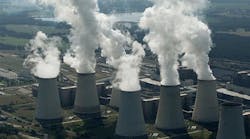Prime Minister Justin Trudeau’s government is speeding up Canada’s planned elimination of traditional coal-fired power plants, doubling down on green pledges as its top trading partner moves in the opposite direction.
Environment Minister Catherine McKenna said on Nov. 21 that the country would phase out traditional coal power by 2030, an acceleration of existing measures that the government says affects four facilities in Canada not already facing retrofit or shutdown by then. They include two facilities in Nova Scotia owned Nova Scotia Power, an Emera Inc. subsidiary, and one each in Saskatchewan and New Brunswick owned by provincial crown corporations.
Canada, which already draws 80% of its electricity from non-emitting sources, is pressing ahead with plans to cut greenhouse gas emissions amid warnings from Trudeau’s political opponents that doing so will create a competitive imbalance with the neighboring U.S., where President-elect Donald Trump wants to back out of climate pledges and boost coal production.
“Phasing out coal-fired electricity and expanding clean power sources will create new jobs and opportunities,” said McKenna. Eliminating smog caused by coal power generation will also reduce health impacts, she said.
Trudeau has unveiled a series of environmental measures in recent months, including a minimum price on carbon and expanded funding for marine protection. His centrist Liberal Party is trying to balance demands of environmental advocates with spurring Canada’s sluggish economic growth. Trudeau faces deadlines to decide on three pipeline projects over the next month.
Carbon Capture
The change essentially requires coal plants to meet a tougher emissions standard -- 420 metric tons of carbon dioxide per gigawatt hour -- more quickly than previously scheduled, unless they adopt carbon-capture technology to cut emissions. If they convert to natural gas, they need only meet a 550 metric ton standard until 2045, when the tougher standard kicks in. McKenna also said she’d work with provinces on equivalency agreements, leaving the door open to keep coal plants running if emissions cuts are found elsewhere.
The move will see Canada generate 90% of electricity from non-emitting sources by 2030, McKenna said. It will also cut emissions by 5 metric megatons, the equivalent of taking 1.3 million cars off the road, according to government estimates.
Coal power represents about 8% of Canadian greenhouse gas emissions, the government said. It accounts for about 11% of the country’s electricity, concentrated mostly in Alberta and Saskatchewan, and also in New Brunswick and Nova Scotia, according to a report issued on Nov. 21 by the Pembina Institute, an environmental think-tank.
‘Disingenuous Commitment’
Alberta and Saskatchewan are major oil producers reeling from the impacts of a commodities slump. Alberta has already pledged its own coal phase-out, while Saskatchewan is balking at Trudeau’s earlier announcement of a minimum carbon price.
Saskatchewan Premier Brad Wall criticized Trudeau for again preempting a December meeting with provincial leaders, where a pan-Canadian climate strategy is due to be discussed.
“These actions have severely undermined the December meeting and have exposed the Prime Minister’s disingenuous commitment to federal-provincial collaboration,” Wall said in a statement. “We will continue to strongly oppose any attempt to impose a federal carbon tax on Saskatchewan and will not support any agreement at the December meeting unless the proposed federal carbon tax is withdrawn.”
Ontario -- Canada’s most populous province -- phased out coal over the past decade. Air quality has improved while electricity rates in the province have roughly doubled. McKenna said the government was “working to ensure” the coal phase-out in other provinces does not increase rates and provided no further details.
The federal government didn’t announce new funding for provinces to shut down coal power. Earlier this month, however, it announced billions in new funding for unspecified green infrastructure, as well as the creation of an infrastructure bank.
By Josh Wingrove



